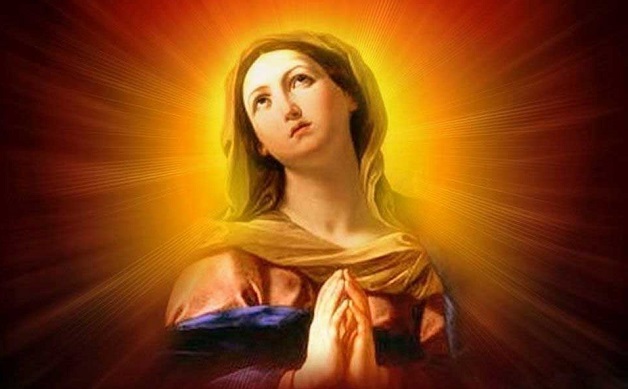The word rosary means “crown of roses”. The conviction behind this expression is that Mary has revealed that each time people say a “Hail Mary” they are giving her a rose.
 A portrait of Mary.
A portrait of Mary.
(This is an excerpt from the forthcoming book by Leonardo De Chirico, ‘A Christian’s Pocket Guide to Mary: the Mother of God?’ (published by Christian Focus).
Mariology is not a peripheral part of spiritual life for many religious people around the world. Intertwined with lofty dogmatic definitions, it is the practice of devotional and popular Marianism that largely defines the religious experience of many Roman Catholic faithful who pray to her and are devoutly committed to her. The Catechism goes as far as saying that “the Church’s devotion to the Blessed Virgin is intrinsic to Christian worship” (971). It also implies that when dealing with Marian devotion, one touches a central nerve of the whole of Christian spirituality, not something that can be dealt with independently. So far, in looking at the development of Mariology throughout the centuries, and the incremental theological significance attached to it, the focus has been both historical and theological. At this point, we want to concentrate on the manifold aspects of Marian devotions to appreciate their phenomenological variety, religious depth, and social pervasiveness in people’s lives.
Prayers
Prayer to Mary is what quintessentially defines Marian spirituality. Mary is perhaps the most invoked figure in many religious quarters. As an acclaimed mother, she is movingly sought by those seeking help and strength. As she is eminently given veneration, she is approached with reverence and awe. As she is magnified with extravagant titles, she has centre stage in peoples’ hearts.
An entry point into the world of Marian prayers is the collection put together by Alphonsus Liguori (1696-1787). Liguori, an Italian Catholic bishop who was proclaimed saint in 1839 and eventually Doctor of the Church in 1871, spent many years gathering the best material on Mary he could find from various sources that were used in the liturgical practice of the church.[1] In his book, Liguori explains that Mary is “our life, our sweetness and our hope,” and goes on to argue that Mary’s intercession on our behalf is powerful to the point of enabling sinners to regain the state of grace. Mary can be approached confidently because she can obtain for us from her divine Son anything she asks for. Moreover, devotion to her is a most certain mark of eternal salvation. This book has been shaping Marian devotions since becoming the reference point for subsequent Mariological reflection. Against the background of such deep theological and devotional vision, the list of prayers mirrors a Marian-centred spirituality: “Hail Holy Queen”, “Regina Coeli” (Queen of Heaven), and “Ave Maris Stella” (Hail Star of Ocean) are only few of the most common and popular Marian prayers.
Rosary
Another significant form of Marian prayer is related to the Rosary. The word rosary means “crown of roses”. The conviction behind this expression is that Mary has revealed to several people that each time they say a “Hail Mary” they are giving her a rose and each complete Rosary makes her a crown of roses. The rose is the queen of flowers, and so the rosary is the rose of all devotions and therefore the most important one. The Holy Rosary is considered a perfect prayer because within it is the awesome story of salvation retold in a way that highlights Mary’s central role in redemption. With the Rosary, devotees meditate on the mysteries of joy, sorrow, and the glory of Jesus and Mary, thus internalizing the blurred analogy between Mary and the Son.[2] Gone is the story of salvation through Christ’s death and resurrection as the Bible tells it. Instead, the Rosary is a powerful tool to shape one’s own imagination in terms of the pervasive presence and agency of Mary in whatever the Triune God is and does. The whole orientation of Roman Catholic “biblical theology” is inherently Marian, in that Mary is thought of as sharing the prerogatives and roles of the Son.
Marian devotions profoundly shape the life of prayer, religious arts, the arrangement of sacred space and time, the imaginations and emotions of people, even becoming a reference point in mapping global territory. In all its theological force and devotional ramifications, Mariology is an inescapable, all-embracing, and fundamental tenet of Roman Catholic theology and practice. Moreover, it is a deeply troubling development because it is impossible to see a linear and coherent connection between this Marian devotion and the more sobering account of what the Bible actually says about Mary.
Leonardo De Chirico, theologian, evangelical pastor and Director of the Reformanda Initiative.
[1] Part of this collection can be found in St. Alphonsus Liguori, Hail Holy Queen. An Explanation of the Salve Regina (Rockford, IL: Tan Books and Publ., 1995).
[2] A full explanation of the significance of the Rosary can be found in John Paul II’s Apostolic Letter Rosarium Virginis Mariae (2002): https://w2.vatican.va/content/john-paul-ii/en/apost_letters/2002/documents/hf_jp-ii_apl_20021016_rosarium-virginis-mariae.html.

Las opiniones vertidas por nuestros colaboradores se realizan a nivel personal, pudiendo coincidir o no con la postura de la dirección de Protestante Digital.
Si quieres comentar o